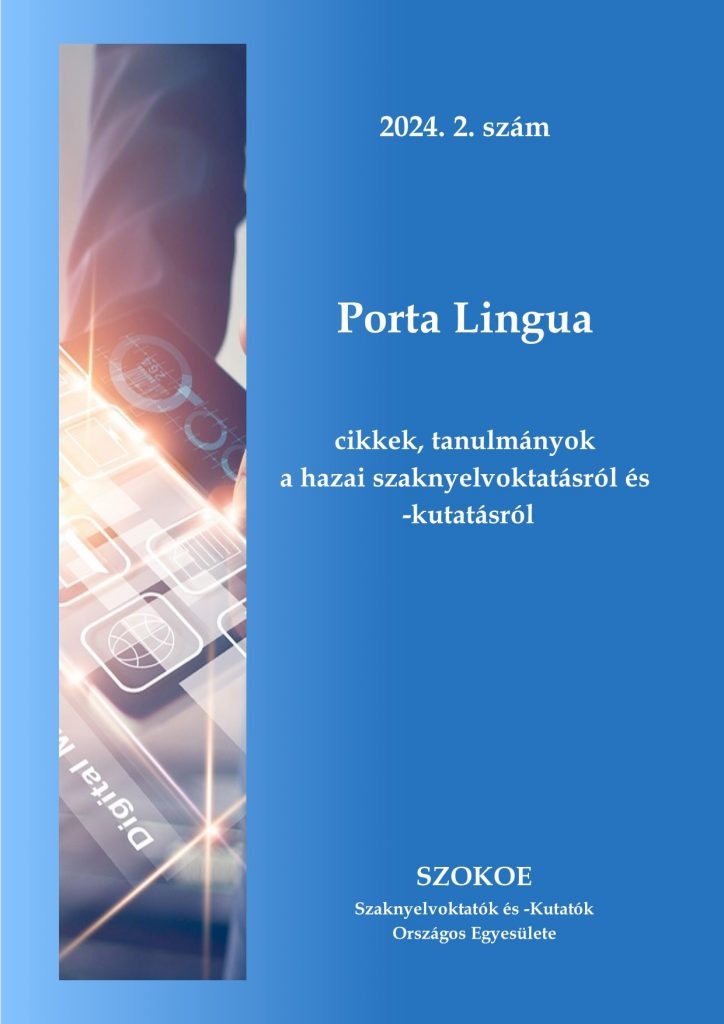Technological competence of specialised translators in the digital age: focus on machine translation and artificial intelligence
Abstract
The study examines the area of technological competence of specialised translators, in the light of competence models from the past decade (PACTE, 2003/2017; EMT, 2017/2022; eTransFair, 2018; TEKOM, 2018; CIUTI, 2018) and of various industry surveys conducted in an international and national context (HUNNECT, 2021; ELIS, 2023 and 2024; Proford and SZOFT, 2024). It also explores the main trends in machine translation (MT) and artificial intelligence (AI), identifiable first from the perspective of market players and then from that of training institutions. Finally, it draws some lessons and makes suggestions based on the relevant literature published in Hungary in recent years.
References
Eszenyi, R. (2023): Humán fordító és gépi fordítás 8 leckében: Változások a 21. századi nyelvi közvetítői szerepében. ELTE BTK: Budapest. DOI: https://doi.org.10.21862/Transl.HuXMach.2023.8
Fáy, T. − Yang, Z. G. (2023): A gépi fordítás szerepe a fordítóképzésben. Modern Nyelvoktatás. 29/1–2. 24–34. DOI: https://doi.org.10.51139/monye.2023.1-2.24.34
Fischer, M. − Szabó, Cs. (2023): Machine translation and post-editing competence: Theory, practice and training. BME Autumn Conference, Translating Europe Workshop, University of Technology and Economics (BME). Across Languages and Cultures. 24/1. 145–149. DOI: https://doi.org/10.1556/084.2023.00512
Heltai, P. (2014): Mi az, amit a gép nem tud fordítani? In: Fata, I. – Veresné Valentinyi, K. (szerk.): Tanulmányok a szakfordítás és a fordítóképzés aktuális témáiról. Szaknyelv és szakfordítás. 7–30. Online elérhető: szie_2014_vegleges_szakfordito.pdf
Kóbor, M. (2023): Gépi fordítás (nem csak) a fordítóképzésekben: Módszertani adalék a tudatos MT-használat oktatásához. Modern Nyelvoktatás. 29/1–2. 7–23. DOI: https://doi.org/10.51139/monye.2023.1-2.7.23
Kóbor, M. – Szlávik, Sz. (2024): Hibaazonosítás és -tudatosítás az utószerkesztési kompetencia fejlesztésében. Fordítástudomány. 26/1. 59–70. DOI: https://doi.org/10.35924/fordtud.26.1.4
Massey, G. (2018): T&I graduate employability strategies in the 21st century. In: Conférence internationale permanente d'instituts universitaires de traducteurs et interprètes (CIUTI), Edinburgh, 29-30 May 2018. Online elérhető: https://www.researchgate.net/publication/326805718_TI_graduate_employability_strategies_in_the_21st _century
PACTE (2017): PACTE Translation Competence model. A holistic, dynamic model of translation competence. In: Hurtado Albir, A. (ed.) Researching translation competence by PACTE group. John Benjamins Publishing Company: Amsterdam/Philadelphia. DOI: http://doi.org/10.1075/btl.127.02pac
Pym, A. (2024): On the end of translation studies as we know it. Abstract for a talk at the XII International Scientific Conference Major Problems of Translation Studies and Translator/Interpreter Training, to be held online at V. N. Karazin Kharkiv National University, Ukraine, on 19-20 April 2024. Online elérhető: dspace cover page (unimelb.edu.au)
Robin, E. − Eszenyi R. (2022): BME TFK Őszi Konferencia. Translating Europe Workshop (Budapesti Műszaki és Gazdaságtudományi Egyetem, Gazdaság- és Társadalomtudományi Kar, Idegen Nyelvi Központ, 2022. szeptember 30.). Fordítástudomány. 24/2. 184‒191. DOI: https://doi.org/10.35924/fordtud.24.2.10
Seidl-Péch, O. (2023): Tiltjuk, tűrjük vagy támogatjuk? Gépi fordítás a fordítóképzésben: Beszámoló a szakfordító szakmai napról (Budapest, 2023. február 16.). Modern Nyelvoktatás. 29. évf. 1–2. szám. 210211. Online elérhető: Tiltjuk, tűrjük vagy támogatjuk? Gépi fordítás a fordítóképzésben | Modern Nyelvoktatás (elte.hu) DOI: https://doi.org/10.51139/monye.2023.1-2.24.34
Sulyok, K. (2023): Kérdőíves felmérés a fordítói, a lektori és az utószerkesztői kompetencia megítéléséről a fordítóiparban. Fordítástudomány 25. évf. 2. szám. 34‒57. DOI: https://doi.org/10.35924/fordtud.25.2.3
Szabó, Cs. (2018): Szakfordítói kompetenciaprofil, képzőintézményi SWOT-elemzés, és szakfordítói mintatanterv: a BME INYK eTransFair projektjének első eredményei. Porta Lingua. Szaknyelvoktatók és Kutatók Országos Egyesülete: Budapest. 61–75.
Szabó, Cs. (2020): Fit-for-market specialised translator and interpreter training: a Hungarian example. In: Besznyák, R. ‒ Szabó, Cs. ‒ Fischer, M. (eds.) Fit-for-Market Translator and Interpreter Training in the Digital Age. Vernon Press: Malaga. 3–24.
Szlávik, Sz. (2022): A gépi fordításhoz kötődő alapvető terminusok, definíciók és a közöttük lévő ellentmondások. Fordítástudomány. 24/1. 87‒103. DOI: https://doi.org/10.35924/fordtud.24.1.6
Szlávik, Sz. (2023): Az utószerkesztési kompetencia (PE) fejlesztésének lehetőségei. Modern Nyelvoktatás 29. évf. 1–2. szám. 35–48. DOI: https://doi.org/10.51139/monye.2023.1-2.35.48
Valentinyi, K. (2022): A gépi fordítás kihívásai a szakfordítóképzésben. Porta Lingua. 2022/1. 69–80. DOI: https://doi.org/10.48040/PL.2022.1.7
Internetes hivatkozások
AI Act (2023). http://www.eur-lex.europa.eu CIUTI (2018).
CIUTI - Excellence in T&I Training and Research
EMT (2009). The EMT translator competence model (2009) (1library.net)
EMT (2017/2022). EMT_Competence_FWK_2017_EN_WEB.indd (europa.eu)
eTransFair. (2018). Szakfordítói kompetenciaprofil - eTransFair.eu (bme.hu)
ELIS (2023). ). EUROPEAN LANGUAGE INDUSTRY SURVEY 2023 (elis-survey.org)
ELIS (2024). EUROPEAN LANGUAGE INDUSTRY SURVEY 2024 (elis-survey.org)
HUNNECT (2021). Hunnect-Felmeres-a-gepi-forditasrol-2021.pdf
PACTE (2003). 2003_Benjamins_PACTE.pdf (uab.cat)
Proford és SZOFT iparági felmérés (2024). TEW HU - A magyar fordítóipar a számok tükrében (youtube.com)
TEKOM (2018). Kompetenzmodell-Strukturansicht (technical-communication.org)
TEKOM (2024) 2024_03_11_tekom_Europe_Position_Paper_AI_Act.pdf (technical-communication.org)



